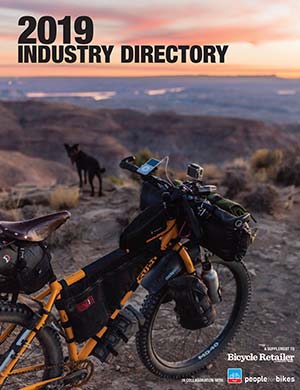BOULDER, Colo. (BRAIN) — If the bike industry has a $1 million question, it is this: How do we get more people riding? How to stop ridership decline and reverse the trend out of the red and into the black is a giant problem that requires a solution of equally epic proportions.
When the 20 Collective formed a couple of years ago, that was its goal. This retailer-founded group, which grew out of a dealer panel hosted by Shimano, first proposed a national 'Got Milk?'-inspired campaign to reach the general public and get them excited about biking.
Fast forward to 2018, and that idea has evolved from an advertising campaign to a new program the 20 Collective conceived with PeopleForBikes. It's powered by technology developed by Black River, a software company founded by industry veteran Eric Lynn.
The PeopleForBikes Ride Guide is a web and app-based platform designed to direct riders of all levels to the best rides in their communities and the places they visit. It's part route finder, part information library and part social network, to connect people with resources to make their ride better, safer and more enjoyable so that they will continue to ride, and do so more often.

For PeopleForBikes, the Ride Guide is a missing link, completing the circle of its advocacy, lobbying and infrastructure expansion efforts by providing a tangible way to help demystify cycling and get more people on bikes. And ultimately, to move the industry forward and grow the pie.
But because the Ride Guide is still in its infancy, PFB president Tim Blumenthal remains cautiously optimistic.
"We still have a lot of work to do. We need to raise more money and fully engage more of our partners in the bike industry — suppliers, distributors, and retailers. We are excited, optimistic and determined. We are getting almost universal positive feedback through dozens of meetings. From these meetings we are co-creating an even better program," he said. "We know this isn't a slam dunk and that there are no silver bullets. It is big and it is daunting. But we think it is a logical next play in our playbook."
PeopleForBikes is in the process of raising $1.2 million to take the Ride Guide to market, and is almost halfway there. The funding will provide staffing to service retailers and affiliates, develop content including videos and training modules, and conduct data analysis. PeopleForBikes is hoping for a July launch, provided funding goals have been met.
Targeted to the casually engaged rider, the Ride Guide is a resource that is meant to help dissolve barriers that might keep them from riding more.
"PeopleForBikes research tells us that there are 25 to 35 million riders who ride five to 10 times per year. It's important to think about the spectrum of cycling. On the far left you have the no way, no how, I'm never going to ride, a group that is expensive and hard to convert," said Jenn Dice, vice president of business network and government relations at PFB. "On the far right you have the enthusiasts, the people the industry already talks to. We're speaking to the middle, the people who go out a few times per year, or maybe go to spin class. We want to get them to ride the bike they purchased more often. Usually we sell a bike and then never see them again. If they have a bad experience, we may never get them back."
Cycling routes, including distance, elevation, photos and other information, can be uploaded to the ride program by anyone. The routes are searchable on the Ride Guide website and app, and businesses will be able to embed branded pages on their websites and social media platforms.

For retailers or anyone wanting to participate, there is a one-time set up process that Lynn said should take a couple of hours to complete. Once routes are loaded, they show up on a map, along with icons representing area bike shops and local events. Elevation profiles, distance, turn-by-turn instructions and other information is also displayed. Businesses or organizations can then share the route with customers via email or social media.
A corresponding paper ride card can also be printed. Users can scan a QR code with a smartphone and load the ride onto their phone, where Siri will guide navigation. Another important component is a content library that will include podcasts, tips and videos, addressing everything from how to fix a flat to helping people find clinics in their area.
The Ride Guide will be free, with some premium features that will be available for a yet-to-be-determined fee. Beyond helping retailers and increasing participation, PeopleForBikes also sees the Ride Guide as a way to support its existing programs.
"Our No. 1 play is advocacy, and this will grow the army. People who use the Ride Guide automatically become PeopleForBikes members. Our number two play is infrastructure. It will help us see holes in routes and points of connectivity that are bad," said Dice. "The Ride Guide will support many of the important projects PeopleForBikes is already doing, and is really the third leg of our stool because it's going to help people ride more and demystify bicycling."
To learn more, visit peopleforbikesrideguide.com, and check out Bicycle Retailer's April 15 print edition for an in-depth story.










